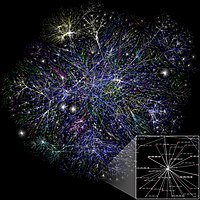
Photo from wikipedia
Despite linear-optical fusion (Bell measurement) being probabilistic, photonic cluster states for universal quantum computation can be prepared without feed-forward by fusing small n-photon entangled clusters, if the success probability of… Click to show full abstract
Despite linear-optical fusion (Bell measurement) being probabilistic, photonic cluster states for universal quantum computation can be prepared without feed-forward by fusing small n-photon entangled clusters, if the success probability of each fusion attempt is above a threshold, $${\mathrm{\lambda }}_{\mathrm{c}}^{(n)}$$λc(n). We prove a general bound $${\mathrm{\lambda }}_{\mathrm{c}}^{(n)} \ge 1/(n - 1)$$λc(n)≥1∕(n-1), and develop a conceptual method to construct long-range-connected clusters where $${\mathrm{\lambda }}_{\mathrm{c}}^{(n)}$$λc(n) becomes the bond percolation threshold of a logical graph. This mapping lets us find constructions that require lower fusion success probabilities than currently known, and settle a heretofore open question by showing that a universal cluster state can be created by fusing 3-photon clusters over a 2D lattice with a fusion success probability that is achievable with linear optics and single photons, making this attractive for integrated-photonic realizations.Universal cluster states for quantum computing can be assembled without feed-forward by fusing n-photon clusters with linear optics if the fusion success probability is above a threshold p. The authors bound p in terms of n and provide protocols for n = 3 clusters requiring lower fusion probability than before.
Journal Title: Nature Communications
Year Published: 2019
Link to full text (if available)
Share on Social Media: Sign Up to like & get
recommendations!